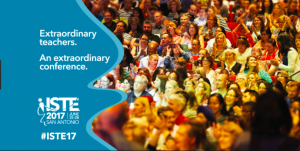ISTE 2017 Reflections and take-aways
by Brian Beaver
Take-away #1: It is not possible for a teacher to know everything about the use of technology in education. Walking into the conference, I was amazed and excited by the number and types of sessions, workshops, speakers and other opportunities to learn how to use technology in teaching science. I was also, frankly, humbled and concerned by this amount of information. There was no way for me to see it all.
I resolved to jump into the work and learn all that I could without feeling badly about all the things that I would surely miss. I also tried to keep in mind a general principle that can be easy for me to forget: to make sure that exciting technology does not get in the way of learning. Good technology in education promotes creativity, collaboration, communication and problem solving.
Take-away #2: Technology will play a pivotal role in project-based learning and applied learning in science at Park School. In science, students identify questions to be studied, collaborate with others, collect and analyze data and communicate findings. At ISTE, I leaned about apps, websites and hardware that allow students to do these things.
For example, students can participate in a “bioblitz” to observe and record all of the plants and animals in an area and to add this data to a public database (http://www.inaturalist.org/pages/bioblitz+guide). Also, students can collect data in the lab and in the field digitally with sensors. I saw a variety of such hardware, for example, Vernier sensors (https://www.vernier.com/products/sensors/). Furthermore, I learned about an online graphing tool, which includes hundreds of authentic data sets from primary sources (https://tuvalabs.com).
Take-away #3: The use of technology in the classroom is a great way for students to learn about engineering, design thinking and coding. At Park, students have been learning about programming in several ways; at ISTE, I learned more about these ways including Code.org, Scratch (https://scratch.mit.edu), and programming with robotics such as Lego spheros and EV3 (http://www.legoengineering.com/category/support/get-started/).
In one session I learned how students can design and engineer solutions to problems by building Lego robots and programming them. In another session, I learned about low cost ways to build a robotic arm and other “ tech-hacks” (https://www.microsoft.com/en-us/education/education-workshop/default.aspx). I also attended sessions in which I learned how schools are using 3D printers. I tried my hand at designing an object to be printed. This was challenging and humbling as my design for a coaster for drinks ended up with a hole right in the middle of it.
Currently, the science department has made good strides with the use of technology. For example, we use digital sensors, graphing software, Google slides, Google sheets, simulations and virtual labs. Looking ahead, the science department will continue to incorporate new and exiting technology – such as those that I observed at ISTE – with the goal of teaching creativity, collaboration, communication and problem solving.


Leave a Reply to Anonymous Cancel reply
You must be logged in to post a comment.